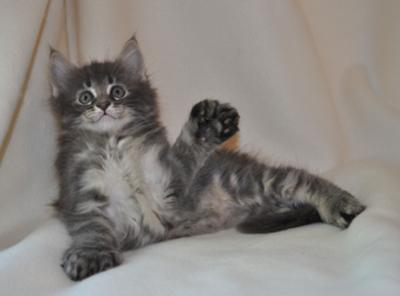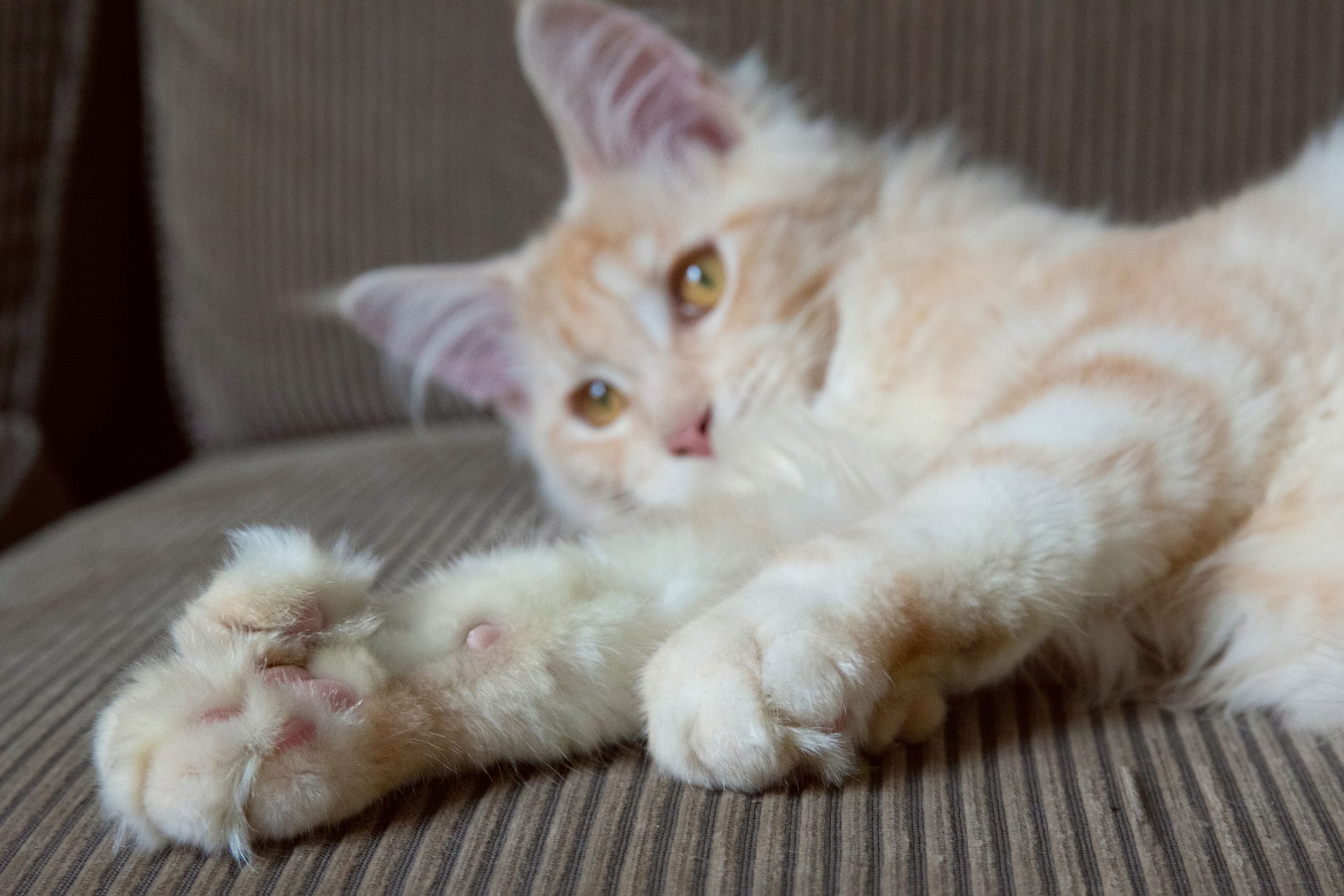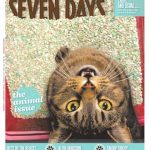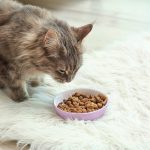Maine Coon Cat With Thumbs : Uncover the Fascinating Polydactyl Trait
A polydactyl Maine Coon is a Maine Coon with extra toes, usually double-wide in size, making their paws appear larger. These extra digits can be found on all four paws and are a unique characteristic of this breed.
Despite the name, polydactylism is not exclusive to Maine Coons and can be found in other cat breeds as well. The presence of extra toes does not necessarily indicate that a Maine Coon is polydactyl, as it is not a mandatory trait for the breed.
However, when present, it adds to the distinctive look of these already majestic cats.
Polydactyl Maine Coon Cats: An Introduction
Introducing the fascinating world of Polydactyl Maine Coon Cats, where these magnificent felines possess extra digits known as thumbs. These multi-toed beauties boast double-wide paws, making them truly unique among their Maine Coon counterparts. Discover the history and characteristics of these adorable double-pawed kitties.
What Is A Polydactyl Maine Coon?
A polydactyl Maine Coon is a Maine Coon cat with extra toes. “Polydactyl” means multi-toed, and these extra-large paws are often referred to as double-paws because they are usually double-wide in size. While most cats have five digits on their front paws and four digits on their back paws, polydactyl cats can have up to seven digits on each paw, with eight being a rare exception.
Extra Toes And Their Significance In Maine Coon Cats
The presence of extra toes, also known as polydactylism, is a genetic trait that is relatively common in Maine Coon cats. These additional digits offer several unique advantages to the breed:
- Enhanced balance: The extra toes provide Maine Coon cats with a wider base of support, allowing them to navigate various terrains with exceptional stability and agility.
- Improved grasping ability: The additional digits give Maine Coons a greater ability to grab objects and hold onto them tightly. This skill is particularly useful in hunting and playing.
- Amplified hunting skills: With their enhanced gripping capability, Maine Coon cats with extra toes can catch prey more effectively. Their polydactylism gives them an advantage in catching fast-moving targets, making them excellent hunters.
It’s important to note that while extra toes may offer certain benefits, they do not hinder the overall health or well-being of Maine Coon cats. In fact, many owners consider the presence of extra toes to be a charming and distinctive feature of the breed.
| Advantages of Extra Toes in Maine Coon Cats |
|---|
| Enhanced balance |
| Improved grasping ability |
| Amplified hunting skills |
If you’re considering adopting a Maine Coon cat, keep in mind that not all Maine Coons are polydactyl. It’s a unique genetic trait that can be found in certain bloodlines or breeders. Understanding the significance of extra toes in Maine Coons will help you appreciate the special characteristics of these magnificent creatures.
The Origins And History Of Polydactyl Maine Coon Cats
The polydactyl Maine Coon cat, also known as the Maine Coon cat with thumbs, is a unique breed with extra toes. These extra-large paws are often double-wide in size, setting them apart from regular Maine Coon cats. Discover the fascinating origins and history of this multi-toed feline companion.
Early Mentions Of Polydactyl Cats In History
Polydactyl cats have a long and intriguing history that can be traced back to ancient times. In fact, there are records of polydactyl cats dating as far back as the ancient Egyptians. These cats were often considered sacred and revered for their unique and unusual appearance. The extra toes on their paws were believed to bring good fortune and were seen as a sign of prosperity.The Role Of Captain Charles Coon In Popularizing Polydactyl Maine Coons
One of the key figures in the popularization of polydactyl Maine Coon cats is Captain Charles Coon. Captain Coon was a seafarer and a renowned cat lover. It is believed that he played a significant role in breeding and developing the polydactyl trait in Maine Coons. As a sea captain, Captain Coon frequently encountered polydactyl cats during his travels and recognized their value. He began selectively breeding these cats to preserve the polydactyl trait and enhance the characteristics of the Maine Coon breed.The Connection Between Polydactyl Cats And Seafaring Communities
Polydactyl cats have a strong connection to seafaring communities. It is believed that the polydactyl trait was naturally selected for in cats living near seaports due to the advantages it provided in navigating ships and climbing ropes. The extra toes on their paws allowed them to maintain a better grip, making them excellent mousers and companions for sailors. Over time, polydactyl cats became highly valued on ships and were even considered good luck charms. The relationship between polydactyl cats and seafaring communities is particularly strong in the state of Maine, where the Maine Coon breed originated. Maine was a hub of maritime activity, and it is likely that polydactyl cats were brought to the region by sailors. These cats thrived in the harsh and cold climate of Maine, and their unique features became a defining characteristic of the Maine Coon breed. In conclusion, the origins and history of polydactyl Maine Coon cats are deeply rooted in ancient times and seafaring communities. The presence of these cats can be traced back to the ancient Egyptians, and their connection to sailors and ships played a crucial role in their development and popularity. Thanks to the efforts of individuals like Captain Charles Coon, polydactyl Maine Coon cats have become a beloved and distinctive breed with their extra toes and captivating charm.Characteristics And Appearance Of Polydactyl Maine Coon Cats
A polydactyl Maine Coon is a Maine Coon cat with extra toes, making their paws usually double-wide in size. The term “polydactyl” means multi-toed, and these cats have unique characteristics that set them apart from regular Maine Coons.
Polydactyl Maine Coon cats, also known as “double-paws,” are a unique variation of the Maine Coon breed. While Maine Coons are already known for their impressive size and elegant appearance, polydactyl Maine Coons have the added feature of extra toes on their paws. In this section, we will explore the physical traits of polydactyl Maine Coons, the unique features of their paws and toes, and how polydactylism affects their overall appearance.Physical Traits Of Polydactyl Maine Coons
Polydactyl Maine Coons showcase several physical traits that set them apart from their non-polydactyl counterparts. Here are some key features of polydactyl Maine Coons:- Larger Paws: One of the most noticeable characteristics of polydactyl Maine Coons is their disproportionately larger paws. These paws are often double-wide in size compared to other cats.
- Extra Toes: Unlike regular cats, polydactyl Maine Coons can have up to seven digits on each paw, with the rare exception of having eight digits.
- Size: These cats are already known for their large size, and their polydactyl variation often amplifies this feature.
- Coat: Polydactyl Maine Coons typically maintain the luxurious and thick coat that is characteristic of the Maine Coon breed.
- Facial Features: They have the same prominent facial features, expressive eyes, and lynx-like tufts on their ears as non-polydactyl Maine Coons.
Unique Features Of Their Paws And Toes
The paws and toes of polydactyl Maine Coon cats are a sight to behold. Here are some distinguishing characteristics of their paws and toes:- Extra Toes: As mentioned earlier, polydactyl Maine Coons can have several extra toes on each paw. These additional toes are often fully functional and provide enhanced dexterity.
- Different Sizes: The extra digits on their paws can vary in size, sometimes ranging from small, undeveloped nubs to fully formed, functioning toes that are similar in size to the regular toes.
- Variety of Toe Configurations: The arrangement of the extra toes can differ from cat to cat. Some polydactyl Maine Coons might have the extra toes neatly aligned alongside the regular toes, while others might have them scattered or overlapping.
How Polydactylism Affects Their Overall Appearance
Polydactylism has a significant impact on the overall appearance of Maine Coon cats. Here’s how it affects them:- Enhanced Paw Size: The larger paws of polydactyl Maine Coons, combined with the extra toes, give their feet a robust and distinctive appearance.
- Increased Paw Dexterity: The additional toes provide polydactyl Maine Coons with enhanced gripping abilities and fine motor skills.
- Quirky Toe Configurations: The different arrangements of extra toes can give these cats a unique and charming look, adding to their overall appeal.
- Rare and Exclusive: Polydactyl Maine Coons are less common than their non-polydactyl counterparts, making them more sought after and valued by cat enthusiasts.
Genetic Factors And Inheritance Of The Polydactyl Trait
Understanding the genetic basis of the polydactyly in Maine Coons is crucial for breeders and cat enthusiasts alike. The polydactyl trait, characterized by extra toes on the cat’s paws, is a fascinating genetic anomaly that has been observed in certain Maine Coon cat populations. In this section, we will delve into the modes of inheritance for the polydactyl trait and explore the frequency of polydactylism in Maine Coon cat populations.
Understanding The Genetic Basis Of Polydactyly In Maine Coons
The polydactyl trait in Maine Coon cats is believed to be a result of a genetic mutation. At the genetic level, polydactyly is caused by a mutation in a gene that regulates limb development. This mutation leads to the development of extra toes on the cat’s paws. While the exact gene responsible for the polydactyl trait in Maine Coons is yet to be identified, researchers speculate that it may be related to the HOXD gene family, which plays a crucial role in limb development in mammals.
Modes Of Inheritance For The Polydactyl Trait
The polydactyl trait in Maine Coons is inherited in an autosomal dominant manner. This means that a cat only needs to inherit the polydactyl allele from one parent to exhibit the trait. In other words, if one parent is polydactyl, there is a 50% chance that their offspring will also be polydactyl. However, it’s important to note that not all offspring from polydactyl parents will necessarily inherit the trait.
The inheritance pattern of polydactyly in Maine Coons can be better understood through the following table:
| Parent 1 | Parent 2 | Offspring |
|---|---|---|
| Non-polydactyl | Non-polydactyl | Non-polydactyl |
| Non-polydactyl | Polydactyl | Polydactyl (50% chance) |
| Polydactyl | Non-polydactyl | Polydactyl (50% chance) |
| Polydactyl | Polydactyl | Polydactyl |
Frequency Of Polydactylism In Maine Coon Cat Populations
Polydactylism is relatively common in certain Maine Coon cat populations, especially in regions where the trait was historically favored. In fact, the prevalence of polydactyly can vary significantly depending on the geographic location and breeding practices. While there is no definitive data on the exact frequency of polydactylism in Maine Coon cats, anecdotal evidence suggests that it can occur in approximately 40-50% of some breeding lines.
Myths And Misconceptions About Polydactyl Maine Coon Cats
When it comes to polydactyl Maine Coon cats, there are several myths and misconceptions that surround these unique felines. In this section, we will debunk these superstitions, differentiate between polydactyl Maine Coons and Hemingway cats, and dispel common misconceptions about polydactylism.
Debunking The Superstitions Surrounding Polydactyl Cats
There are many superstitions surrounding polydactyl cats, but it’s important to separate fact from fiction. Let’s debunk some of these common misconceptions:
- Polydactyl cats bring good luck: While it may be tempting to believe in the good luck charm of polydactyl cats, there is no scientific evidence supporting this claim. They are just as lucky (or unlucky) as any other cat.
- Polydactyl cats have magical powers: Some people believe that the extra toes on polydactyl cats give them special powers. However, these extra digits are purely genetic variations and do not grant any supernatural abilities.
- Polydactyl cats are more prone to health issues: This is a common misconception, but there is no evidence to suggest that polydactyl cats are more prone to health problems compared to cats with a normal number of toes. As long as they receive proper care and veterinary attention, they can live healthy lives.
Differentiating Between Polydactyl Maine Coons And Hemingway Cats
While both polydactyl Maine Coons and Hemingway cats are known for their extra toes, there are some key differences between the two:
| Polydactyl Maine Coons | Hemingway Cats |
|---|---|
| Polydactyl Maine Coons have extra toes due to a genetic mutation. | Hemingway cats have extra toes due to the influence of Ernest Hemingway, who had a fondness for polydactyl cats. |
| Polydactyl Maine Coons are recognized as a breed trait. | Hemingway cats can be of any breed and are not specific to Maine Coons. |
| Polydactyl Maine Coons are larger in size with a more robust build. | Hemingway cats can vary in size and body type. |
Dispelling Common Misconceptions About Polydactylism
Now, let’s dispel some common misconceptions about polydactylism:
- It is not a deformity: Polydactylism is a genetic trait and is not considered a deformity. The extra toes do not cause any harm or discomfort to the cats.
- It does not affect the cat’s agility: Despite having extra toes, polydactyl cats are just as agile as cats with a normal number of toes. They can climb, jump, and play with ease.
- It is not breed-specific: While polydactyl Maine Coons are more commonly associated with polydactylism, this trait can occur in various other cat breeds as well.
By debunking these superstitions and misconceptions, we can appreciate the uniqueness of polydactyl Maine Coon cats and celebrate them for who they are – adorable, playful, and extraordinary feline companions.

Credit: www.maine-coon-cat-nation.com
Frequently Asked Questions On Maine Coon Cat With Thumbs
What Is A Polydactyl Maine Coon?
A polydactyl Maine Coon is a Maine Coon cat with extra toes. These cats have larger paws, often double-wide in size, and can have up to seven digits on each paw. They are the same as regular Maine Coon cats in every other characteristic.
Is It Common For Maine Coons To Be Polydactyl?
Polydactyl Maine Coons, with extra toes, are not common but can occur due to a genetic mutation. Regular Maine Coons have five digits on the front paws and four digits on the back. Polydactyl Maine Coons can have up to seven digits on each paw.
What Is The Difference Between A Polydactyl Maine Coon And A Regular Maine Coon?
A polydactyl Maine Coon has extra toes, usually totaling up to seven digits on each paw. Regular Maine Coons typically have five digits on the front paws and four digits on the back. The extra toes give polydactyl Maine Coons larger paws.
Conclusion
Polydactyl Maine Coon cats, with their extra toes, are a unique and intriguing breed. These multi-toed felines have paws that are usually double-wide in size, earning them the nickname “double-paws”. While it is not a mandatory characteristic of the Maine Coon breed, owning a polydactyl Maine Coon can be a special and delightful experience.
These extraordinary cats are not only visually appealing but also often come with a higher price tag due to their rarity. If you’re looking for a one-of-a-kind furry companion, a polydactyl Maine Coon may be the perfect choice for you.





